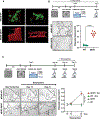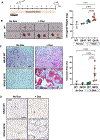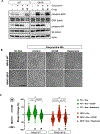NRASQ61R mutation in human endothelial cells causes vascular malformations
- PMID: 35391614
- PMCID: PMC9631803
- DOI: 10.1007/s10456-022-09836-7
NRASQ61R mutation in human endothelial cells causes vascular malformations
Abstract
Somatic mutations in NRAS drive the pathogenesis of melanoma and other cancers but their role in vascular anomalies and specifically human endothelial cells is unclear. The goals of this study were to determine whether the somatic-activating NRASQ61R mutation in human endothelial cells induces abnormal angiogenesis and to develop in vitro and in vivo models to identify disease-causing pathways and test inhibitors. Here, we used mutant NRASQ61R and wild-type NRAS (NRASWT) expressing human endothelial cells in in vitro and in vivo angiogenesis models. These studies demonstrated that expression of NRASQ61R in human endothelial cells caused a shift to an abnormal spindle-shaped morphology, increased proliferation, and migration. NRASQ61R endothelial cells had increased phosphorylation of ERK compared to NRASWT cells indicating hyperactivation of MAPK/ERK pathways. NRASQ61R mutant endothelial cells generated abnormal enlarged vascular channels in a 3D fibrin gel model and in vivo, in xenografts in nude mice. These studies demonstrate that NRASQ61R can drive abnormal angiogenesis in human endothelial cells. Treatment with MAP kinase inhibitor U0126 prevented the change to a spindle-shaped morphology in NRASQ61R endothelial cells, whereas mTOR inhibitor rapamycin did not.
Keywords: Kaposiform lymphangiomatosis; Lymphatic anomaly; RASopathies; Vascular Anomaly; Vascular Malformation.
© 2022. The Author(s), under exclusive licence to Springer Nature B.V.
Figures





References
Publication types
MeSH terms
Substances
Grants and funding
LinkOut - more resources
Full Text Sources
Miscellaneous

